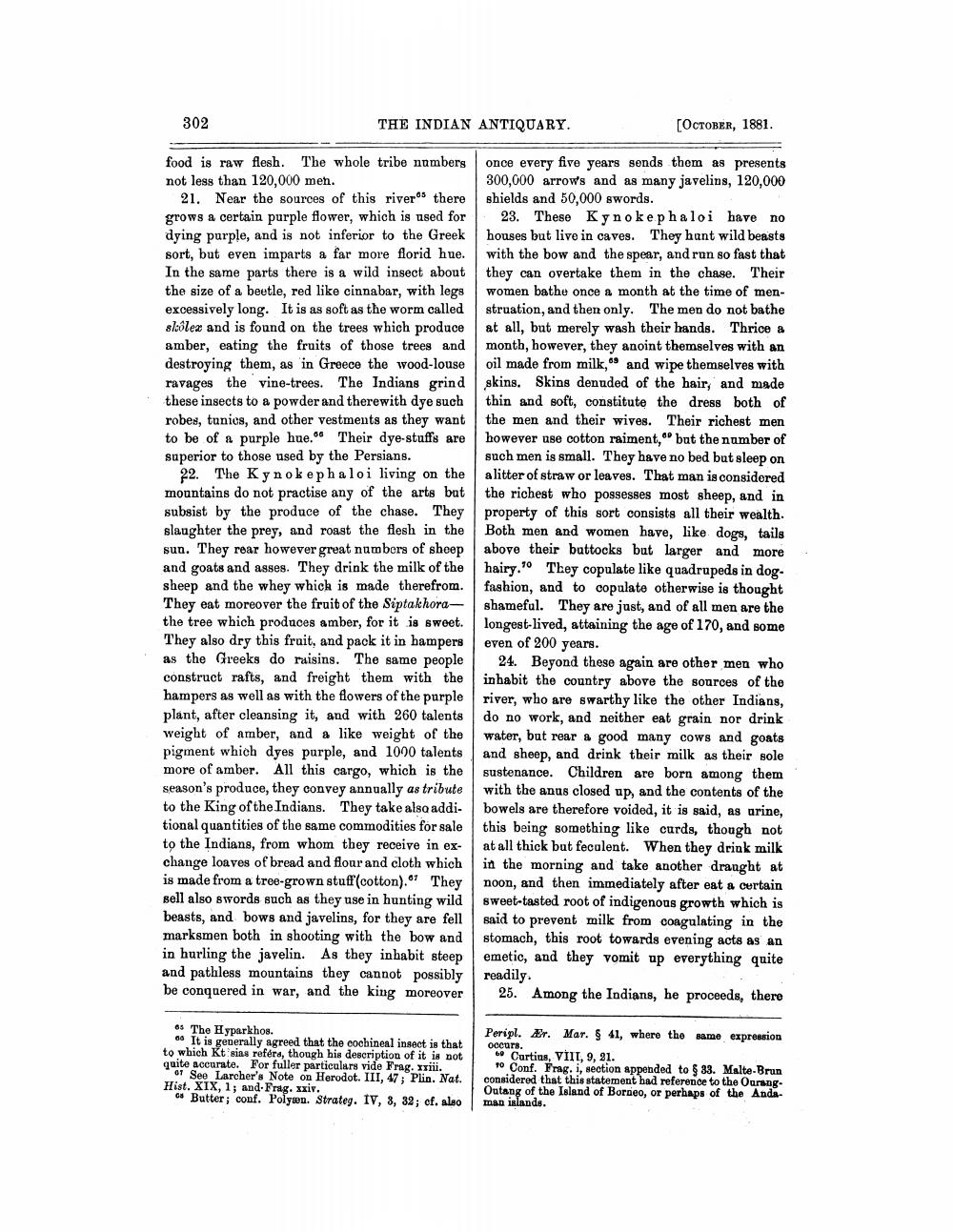________________
302
THE INDIAN ANTIQUARY.
[OCTOBER, 1881.
food is raw flesh. The whole tribe numbers once every five years sends them as presents not less than 120,000 men.
300,000 arrows and as many javelins, 120,000 21. Near the sources of this rivers there shields and 50,000 swords. grows a certain purple flower, which is used for 23. These Kynokephaloi have no dying purple, and is not inferior to the Greek houses but live in caves. They hunt wild beasts sort, but even imparts a far more florid hue. with the bow and the spear, and run so fast that In the same parts there is a wild insect about they can overtake them in the chase. Their the size of a beetle, red like cinnabar, with legs women bathe once a month at the time of menexcessively long. It is as soft as the worm called struation, and then only. The men do not bathe sloblea and is found on the trees which produce at all, but merely wash their hands. Thrice a amber, eating the fruits of those trees and month, however, they anoint themselves with an destroying them, as in Greece the wood-louseoil made from milk, and wipe themselves with ravages the vine-trees. The Indians grind skins. Skins denuded of the hair, and made these insects to a powder and therewith dye such thin and soft, constitute the dress both of robes, tunics, and other vestments as they want the men and their wives. Their richest men to be of a purple hue." Their dye-stuffs are however use cotton raiment, but the number of superior to those used by the Persians.
such men is small. They have no bed but sleep on 22. The Kynokephaloi living on the a litter of straw or leaves. That man is considered mountains do not practise any of the arts but the richest who possesses most sheep, and in subsist by the produce of the chase. They property of this sort consists all their wealth. slaughter the prey, and roast the flesh in the Both men and women have, like dogs, tails sun. They rear however great numbers of sheep above their buttocks but larger and more and goats and asses. They drink the milk of the hairy." They copulate like quadrupeds in dog. sheep and the whey which is made therefrom. fashion, and to copulate otherwise is thought They eat moreover the fruit of the Siptakhora- shameful. They are just, and of all men are the the tree which produces amber, for it is sweet. longest-lived, attaining the age of 170, and some
They also dry this fruit, and pack it in hampers even of 200 years. as the Greeks do raisins. The same people 24. Beyond these again are other men who construct rafts, and freight them with the inhabit the country above the sources of the hampers as well as with the flowers of the purple river, who are swarthy like the other Indians. plant, after cleansing it, and with 260 talents do no work, and neither eat grain nor drink weight of amber, and a like weight of the water, but rear a good many cows and goats pigment which dyes purple, and 1090 talents and sheep, and drink their milk as their sole more of amber. All this cargo, which is the sustenance. Children are born among them season's produce, they convey annually as tribute with the anus closed up, and the contents of the to the King of the Indians. They take also addi- bowels are therefore voided, it is said, as urine, tional quantities of the same commodities for sale this being something like curds, though not to the Indians, from whom they receive in ex- at all thick but fecalent. When they drink milk change loaves of bread and flour and cloth which in the morning and take another draught at is made from a tree-grown stuff'(cotton). They noon, and then immediately after eat a certain sell also swords such as they use in hunting wild sweet-tasted root of indigenous growth which is beasts, and bows and javelins, for they are fell said to prevent milk from coagulating in the marksmen both in shooting with the bow and stomach, this root towards evening acts as an in hurling the javelin. As they inhabit steep emetic, and they vomit up everything quite and pathless mountains they cannot possibly readily. be conquered in war, and the king moreover 25. Among the Indians, he proceeds, there
es The Hyparkhos.
* It is generally agreed that the cochineal insect is that to which Ktsins reféra, though his description of it is not quite accurate. For fuller particulars vide Frag. xviii.
of See Larcher's Note on Herodot. III, 47; Plin. Nat. Hist. XIX,1; and. Frag. xxiv.
64 Butter; conf. Polysen. Strateg. IV, 3, 32; cf. also
Peripl. Ær. Mar. $ 41, where the same expression occurs.
• Curtius, VIIT, 9, 21.
10 Conf. Frag. 1, section appended to $ 33. Malte-Brun considered that this statement had reference to the OurangOutang of the Island of Borneo, or perhaps of the Anda. man islands.




